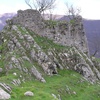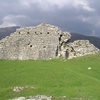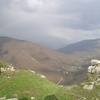Fort of Lucchio
The fortress of Lucchio is a small fortified system on the top of the hill called "Penna di Lucchio", within walking distance of the nearest town. The fortification consists of a large rectangular rock, placed on the point of greatest elevation of the relief and inside a wall which extends over the foothills to the south-west.
Besides the castle you can visit the Church of San Pietro which dates back to the thirteenth century and was radically changed in the seventeenth. Among the interior décor, the baptismal font from the sixteenth century is of particular interest.
The main defensive structure of the fortress, which is accessed from a south-facing portal which has now collapsed, is somewhat complex. You can still see the "buttresses", built around the seventeenth century, in an alternating internal and external arrangement: besides making the fortification more resistant to the impact of artillery, their function was probably also to support and prevent collapse given the tendency of limestone rock on which the structure was built to flake.
Inside the walls were two architectural complexes - now destroyed - that probably had different functions: one of them was to house the castellan, the other provided accommodation for the garrison and served as a depot for the requirements for proper functioning of the fortress. Water supply was ensured by a small tank, built later than the walls and the fortress, in which rainwater was collected.
From an examination of the materials and construction technique used, we can say that the first fortifications date to a period between the twelfth and thirteenth centuries.
Historical notes
The first written record of the existence of the town is in 1260, when the church of San Pietro is mentioned for the first time. The castle, however, is not mentioned prior to 1327, although in all likelihood the area had already been fortified previously through an initiative of the Porcaresi family or that of Lupari, who had held possession. In 1366, when Lucca was still under the domination of Pisa, a warden and fourteen sergeants were elected, while in 1370 the fort was again in full possession of the City of Lucca, which maintained the operation of the fortress by electing castellans and taking charge of the expenses. The military construction definitely underwent restoration in 1385. At the end of the fourteenth centurym the fortress of Lucchio played a key role in defence and control of the territory, because along with the nearby fortress on the hill of "Bastia", which has now completely disappeared, it was situated on the border with the Florentine State. For this reason, in the Chronicles of Giovanni Sercambi, the castle of Lucchio was counted among those which always had to be maintained in good working order. The fortress underwent major renovations again in 1645, the year in which the "buttresses" to the walls were among the additions. A map drawn in 1670 informs us also that to arrive in the nearby village you had to cross a "bridge which when raised closes the entrance to Lucchio", while the structure placed on the west ridge of the "Fortress", which in ancient times was to have had the role of advanced sentinel, is referred to as "the windmill on the hill near the fortress".











